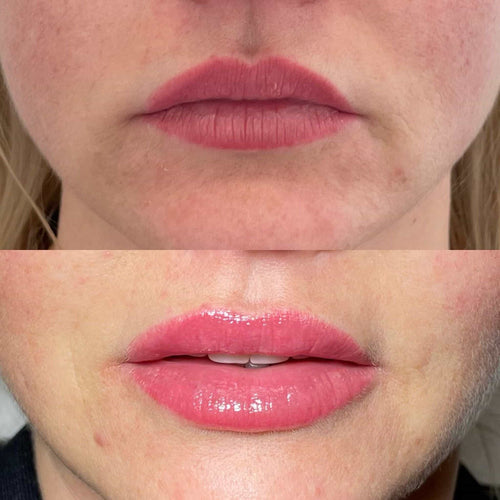Schedule a Dermal Filler Consultation with Dr. Laura Geige Now
The Perils of Facial Fillers: Risky Injection Zones
Areas Prone to Complications
Facial fillers have become increasingly popular, offering a non-surgical way to enhance facial features and reduce signs of aging. However, like any medical procedure, facial injections carry potential risks and complications.
Certain areas of the face are more susceptible to complications than others due to anatomical factors such as blood vessel proximity, muscle movement, and tissue thickness.
Here are some injection zones that are considered particularly risky:
1. **Nasolabial Folds (Smile Lines):**
* These folds run from the nose to the corners of the mouth and are a common area for filler placement.

* Risks include vascular occlusion (blockage of blood vessels) which can lead to necrosis (tissue death), uneven distribution, and lumpiness.
2. **Cheekbones:**
* Injecting fillers into the cheekbones can be complex due to the thinness of the overlying skin and the proximity of important blood vessels.
* Complications may include vascular occlusion, bruising, and contour irregularities. 3. **Lips:**
* While lip augmentation is a popular procedure, it can pose risks if not performed carefully.
* Potential complications include asymmetry, swelling, infection, and arterial occlusion (blockage of arteries).
4. **Under-eye Area:**

* This delicate area requires a skilled practitioner due to the thin skin and proximity to blood vessels and nerves.
* Risks include vascular occlusion, eyelid swelling, puffiness, and bruising.
5. **Temporal Areas (Forehead):**
* Injecting fillers into the temporal areas can be challenging because of the movement of facial muscles.
* Complications may include asymmetry, migration of filler, and lumps.
Schedule a Dermal Filler Consultation with Dr. Laura Geige Today
It is crucial to choose a qualified and experienced injector who understands the anatomy of the face and potential risks associated with each injection zone.
Always discuss your concerns and expectations thoroughly before undergoing any facial filler treatment.
The Dangers of Overfilled Lips
When it comes to facial fillers, safety should always be paramount. While these injections can enhance features and rejuvenate the face, certain areas pose higher risks than others due to their complex anatomy and proximity to vital structures.
One particularly risky area is the eyelid region. The eyelids are delicate with thin skin and a network of blood vessels close to the surface. Injecting fillers here can lead to complications like swelling, bruising, blindness, and even vascular occlusion (blockage of blood flow).
Another high-risk zone is around the nasolabial folds (the lines running from the nose to the corners of the mouth). These folds are located near the facial nerve which controls muscle movement. Incorrect filler placement can lead to facial paralysis, a condition where muscles on one side of the face become weak or paralyzed.
The lips themselves present unique challenges. Overfilling the lips is a common concern, leading to an unnatural and distorted appearance. Excessive filler can also obstruct blood flow, resulting in necrosis (tissue death).
Beyond specific zones, there’s always a risk of allergic reactions, infection, and lumps or bumps at the injection site, regardless of the area.
It’s crucial to choose a qualified and experienced injector who understands facial anatomy and risks. Thoroughly research potential practitioners and ask about their experience, training, and safety protocols.
Remember, natural beauty is often more appealing than overly sculpted features. Opting for subtle enhancements instead of drastic transformations can help minimize risks and achieve a harmonious and youthful look.
Injecting Near Veins: A Recipe for Disaster
Facial fillers are a popular cosmetic treatment that can add volume and enhance facial features. However, they carry inherent risks, particularly when injected into certain areas or near delicate structures like veins.
One of the riskiest zones for filler injections is the tear trough, the area beneath the eyes. This region is prone to bruising and swelling post-injection, and there’s a risk of filler migration, causing an unnatural bulge under the eye.
Another risky zone is the lips. Injecting too much filler can result in an overfilled, “duck lip” appearance. Additionally, improper placement can lead to unevenness or distortion of the natural lip shape.
The nose, also known as the non-surgical rhinoplasty area, poses significant risks. Filler can migrate into surrounding tissues, causing lumps or bumps. Additionally, injecting near the delicate nasal septum, which separates the nostrils, can obstruct airflow and cause breathing difficulties.
Injecting near veins is a particularly dangerous practice. When fillers are deposited too close to blood vessels, they can block blood flow, leading to tissue damage, necrosis (cell death), and even stroke if a major artery is affected.
This “vascular occlusion” risk is elevated when using certain types of fillers, such as those containing hyaluronic acid. This is because these fillers are designed to hold water, increasing the likelihood of blockage in the vein.
Therefore, it’s crucial to choose a qualified and experienced injector who understands facial anatomy and risks associated with different injection zones.
Thorough consultation, realistic expectations, and meticulous injection techniques are essential for minimizing complications and achieving natural-looking results.
Anatomy Matters: Why Some Areas are More Vulnerable
Delicate Tissues and Thin Skin
Understanding the anatomy of our face is crucial when considering any aesthetic procedure, especially dermal filler injections. Certain areas are more vulnerable than others due to a combination of factors such as delicate tissues, thinner skin, and proximity to vital structures.
One key factor influencing vulnerability is skin thickness. Areas like the eyelids, lips, and thin skin around the nose tend to be more susceptible to complications from filler injections. The thinner the skin, the greater the risk of visible bruising, lumps, or distortion.
Another important consideration is the presence of underlying blood vessels and nerves. Injecting filler too close to these structures can lead to vascular occlusion (blockage), nerve damage, or even vision impairment. Areas like the tear trough, nasolabial fold, and glabellar region require meticulous injection techniques to avoid these risks.
Furthermore, anatomical variations contribute to regional differences in vulnerability. Some individuals may have thinner facial muscles or shallower subcutaneous fat layers, making them more prone to filler complications. This highlights the importance of personalized assessments and customized treatment plans based on each patient’s unique anatomy.
The delicate nature of certain facial tissues also plays a role. Areas like the temples, cheeks, and brow are composed of thinner, more fragile structures that can be easily damaged by improper injection techniques. Precise placement and careful dosage are essential to achieve natural-looking results and minimize the risk of complications.
Finally, understanding the lymphatic drainage pathways is crucial for minimizing swelling and bruising after filler injections. Areas with dense lymphatic networks, such as the lower face and neck, require specific injection strategies to prevent fluid accumulation and optimize aesthetic outcomes.
Muscle Movement and Facial Expression
Anatomy Matters: Why Some Areas Are More Vulnerable
Understanding the intricate network of blood vessels, nerves, and muscles in the face is crucial for safe and effective dermal filler injections.
Certain areas are inherently more vulnerable due to their proximity to vital structures.
1. Arteries: Major blood vessels like the facial artery run close to the surface in the midface.
Injecting filler too close can obstruct blood flow, leading to tissue necrosis (death). This risk is higher in areas like the nasolabial folds and cheeks.
2. Nerves: The face is richly supplied with nerves responsible for facial expressions.
Incorrect placement of filler can compress or damage these nerves, resulting in temporary or permanent paralysis, numbness, or pain.
The most common nerve affected is the buccal branch of the facial nerve, which controls movements around the mouth.
3. Muscles: Facial muscles are responsible for our dynamic expressions.
Filler can inadvertently interfere with muscle movement, causing unnatural contortions or limitations in expression.
The areas most susceptible to this include the corners of the mouth and forehead where muscles contract prominently.
Muscle Movement and Facial Expression
Consult Dr. Laura Geige for Dermal Fillers at It’s Me and You Clinic
The human face is incredibly expressive, thanks to the coordinated action of over 40 distinct muscles.
These muscles allow us to convey a wide range of emotions through subtle or dramatic movements.
Filler injections can impact these movements in several ways:
1. Volume Addition: By adding volume to areas like the cheeks and lips, filler can enhance facial expressions by making them appear fuller and more defined.
2. Muscle Relaxation: Some fillers contain ingredients that temporarily relax muscles.
This can be used to smooth wrinkles caused by muscle contractions, such as frown lines between the eyebrows or crow’s feet around the eyes.
3. Muscle Stiffness:
If filler is injected too close to muscles or in an unnatural way, it can cause stiffness and restrict movement.
This can lead to a less natural and potentially more frozen appearance.
Underlying Blood Vessels and Nerves
When considering dermal fillers, it’s crucial to understand that not all areas are created equal. Anatomy plays a significant role in determining risk levels for complications.
**Blood vessels** and **nerves** are key structures that run throughout the body and influence filler placement.
Areas closer to major blood vessels or nerves are inherently more vulnerable to complications like vascular occlusion (blockage) or nerve injury.
Think of it like threading a needle – you’d be more careful when nearing a delicate fabric than a thicker piece of material. Similarly, injectors must exercise heightened caution near vital structures.
The **face** is a complex network of interconnected vessels and nerves.
For example, the nasolabial folds (the creases that run from the nose to the corners of the mouth) are relatively deep, but also lie close to important blood vessels.
Filler placement here requires precise technique to avoid injecting into a vessel.
Another area of concern is around the **eyes**, particularly the lower eyelid**.
This region boasts delicate skin and numerous small blood vessels. Even a small amount of filler injected incorrectly could lead to swelling, bruising, or even blindness in rare cases.
**The lips** are also susceptible due to their rich blood supply. Injecting too much filler can distort the lip’s shape and create an unnatural appearance.
Additionally, the lips often lack a thick layer of fat**, which offers some cushioning for underlying structures.
This makes them more vulnerable to complications when fillers are injected.
Understanding anatomy is fundamental for safe and effective filler treatments. Always consult with a qualified and experienced injector who prioritizes safety and takes the time to thoroughly assess your individual anatomy.
